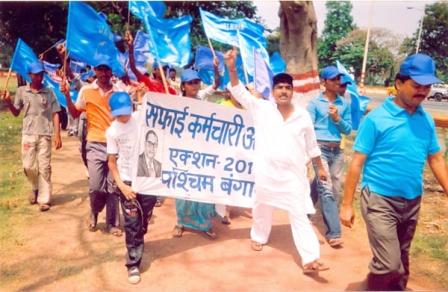/topics/toilets-and-urinals
Toilets and Urinals
Water Supply and Sanitation India Assessment A WHO-UNICEF sponsored study by the Planning Commission of India
Posted on 22 Nov, 2014 10:30 AMThis country-level report on the assessment of drinking water supply and sanitation in India is the result of a collaborative exercise between the Planning Commission of India, the World Health Organization (WHO), and the
New and improved WSSCC website
Posted on 22 Nov, 2014 10:30 AMArticle and Image Courtesy: Water supply and Sanitation Collaborative Council

We are pleased to announce the new and improved, your entry point into the online world of the Water Supply and Sanitation Collaborative Council.
Evaluation of sanitation and wastewater treatment technologies: Case studies from India
Posted on 22 Nov, 2014 10:30 AMThe sanitation systems studied are spread across the country. The study goes to Pratapnagar in Bihar to evaluate the success of the septic tank to Asalthpur in Uttar Pradesh to study the Ecosan (UDDT) toilet. Other locations in India include Maharashtra, Gujarat, Kerala.
Model Schools: Suvarna Jala - A status report by Arghyam 2009
Posted on 22 Nov, 2014 10:30 AM This is a status report of Arghyam's sponsored efforts to develop and showcase community managed water and sanitation systems in 17 schools of 7 districts of Karnataka.
This is a status report of Arghyam's sponsored efforts to develop and showcase community managed water and sanitation systems in 17 schools of 7 districts of Karnataka.
The Government of Karnataka through its Suvarna Jala Yojana aims at providing drinking water in 23,683 rural government schools. This was funded to the tune of Rs 7735 lakh. Arghyam conducted a survey of this scheme in 2007 in 7 districts to ascertain the status of the scheme. The survey found out that out of the 1269 rainwater harvesting structures completed by November 2006 only 140 structures were functional.{C}
Urban local initiatives and government responses A case of Dev Nadi in Pune
Posted on 22 Nov, 2014 10:30 AMMost of the rivers and streams in urban India are dead. With a very few and rare exceptions, these once-beautiful water bodies have been encroached upon, sources dried up or converted into sewage drains all over the country.Water is being sourced or pumped from sites upstream of the city for its needs or from long distances and the city administration has little incentive for cleaning its own muck. The dismal figures of urban sewage treated by sewage treatment plants, their installed capacity and efficiency stand testimony to this.
The employment of manual scavengers and construction of dry latrines prohibition act Directorate of Municipal Administration 1993
Posted on 22 Nov, 2014 10:30 AMThe document goes on to describe the details of the implementation of the Act and includes:
Samajik Parivarthan Yatra National Yatra for Social Transformation
Posted on 22 Nov, 2014 10:30 AM
 The historical ‘Samajik Parivarthan Yatra’ (Rally for Social Transformation), has been started to consolidate the gains of the movement for total eradication by liberated safai karmacharis who for the first time are bonding with one another began the journey for social change together, to inspire others who are still engaged in manual scavenging to free themselves from the obnoxious practise and regain their sense of dignity, and also to achieve their rightful claims for the rehabilitation package and dignified alternative livelihoods on the one hand; and on the other, to motivate civil society to reject the heinous practice of manual scavenging. The Bus Yatra has been planned to start from five different corners of India, and traverse through 160 districts in 20 states and finally culminate in New Delhi with a large rally. Each route has been named after an eminent person who contributed to social change in a revolutionary manner.
The historical ‘Samajik Parivarthan Yatra’ (Rally for Social Transformation), has been started to consolidate the gains of the movement for total eradication by liberated safai karmacharis who for the first time are bonding with one another began the journey for social change together, to inspire others who are still engaged in manual scavenging to free themselves from the obnoxious practise and regain their sense of dignity, and also to achieve their rightful claims for the rehabilitation package and dignified alternative livelihoods on the one hand; and on the other, to motivate civil society to reject the heinous practice of manual scavenging. The Bus Yatra has been planned to start from five different corners of India, and traverse through 160 districts in 20 states and finally culminate in New Delhi with a large rally. Each route has been named after an eminent person who contributed to social change in a revolutionary manner.
Protect the right to life considering the dignity of women who do not have access to a toilet
Posted on 22 Nov, 2014 10:30 AMSanitation - a big problem in India, as half the population of our country do not have access to this facility. Mumbai is one of the biggest cities in the world and advanced in terms of its commercialization. However, sanitation is one of the most common issues neglected. Our team of women from Jan Jagruti went into the lanes of 3 areas Azad Mohala, Bharatiya Kamla Nagar, Vijay Nagar and spoke to women to understand the severity of the sanitation issue prevailing. These areas have severe problems with public health, due to improper sanitation infrastructure and insufficiency of toilet facilities, compounded by numerous issues of flooding during the monsoon season. Khaaddi, a local area/dumping ground, is widely used by local residents for urination and defecation, leading to the spread of contagious diseases. Though women use paid toilets, the issue of cleanliness and waiting in long queues are the most common problem before them. It is very insecure for them when they use open spaces for defecation.
Water Resources Engineering and Management A Civil Engineering Course under the National Programme on Technology Enhanced Learning
Posted on 22 Nov, 2014 10:30 AMThis Civil Engineering Course under the National Programme on Technology Enhanced Learning (NPTEL) on the broad subject of Water Resources Engineering and Management is being carried out by Indian Institute of Technology’s and the Indian Institute of Science, Bangalore as a collaborative project supported by the Ministry of Human Resource Development (Government of India) to enhance the quality of engineering education in the country, by developing curriculum based video and web courses. In these web based lectures, the authors have developed the subject in detail and in stages in a student-friendly manner. The broad group of Water Resources Engineering is structured into modules on the topic by IIT Kharagpur as follows:
ECO Sanitation A beneficial toilet
Posted on 22 Nov, 2014 10:30 AMA brochure from Utthan about Eco-sanitation produced with support from Arghyam.





